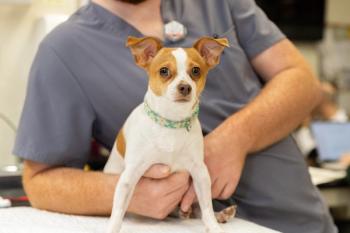
UC-Davis veterinarians use near-infrared technique in complex surgery
New technology may become protocol of choice at veterinary teaching hospitals.
Veterinary surgeons at the University of California-Davis School of Veterinary Medicine have pioneered a new technique that has proven helpful in soft tissue surgical cases-the use of intraoperative near-infrared imaging. Near-infrared imaging uses different wavelengths of light that are not visible to the human eye without special imaging systems but that travel through tissue and fat easily, making it possible for surgeons to visualize what's underneath.
The technique was recently used on a 3-year-old male mastiff that presented to the veterinary teaching hospital for chylothorax, a potentially life-threatening condition in which chyle leaks from the thoracic ducts into the chest. Nearly 2,000 ml of fluid were removed from the dog's chest when he first arrived, but the cause of his condition was still unknown. Chest radiographs, an echocardiogram and a thoracic ultrasound ruled out any structural or functional abnormalities that could cause the chylothorax, and it was determined that there was no clear underlying reason for the patient's condition.
Medical therapy and surgery were two options discussed with the owners, but because the success rate isn't as high with medication alone, the owners elected to pursue the surgical option-thoracic duct ligation. The procedure is often done via an open surgical approach, but UC-Davis offers a thoracoscopic alternative, which is minimally invasive, has a similar success rate and provides less discomfort and a quicker recovery for the patient.
Because the ducts that carry chyle are small and often difficult to see under normal illumination during surgery, Philipp Mayhew, BVM&S, and Michele Steffey, DVM, assistant professors in Surgical and Radiological Sciences at UC-Davis, opted to use intraoperative near-infrared imaging to make them more visible for the thoracic duct ligation procedure.
The process began with the injection of a special medical dye into a lymph node, where it was carried by the lymphatic vessels into the chest to form the thoracic ducts. The dye is generally not visible to the naked eye, and therefore does not distort the appearance of tissues or inhibit the surgeon's field of vision during dissection. However, when surgeons switch from a normal view with the thoracoscope to the near-infrared view, the special dye within the ducts allows them to see their position clearly, enabling dissection and minimizing any chance of missing the ducts. This approach allowed the surgeons to easily locate where the patient was leaking chyle and repair the duct.
Surgeons at UC-Davis believe this near-infrared approach may soon become the optimal protocol to use in all cases such as this. In fact, other schools of veterinary medicine have purchased this equipment and have already begun to utilize the technique.
Newsletter
From exam room tips to practice management insights, get trusted veterinary news delivered straight to your inbox—subscribe to dvm360.





